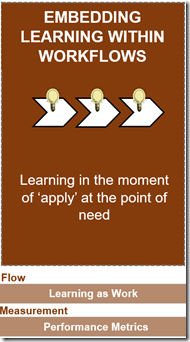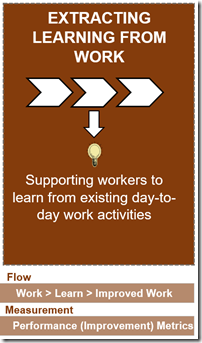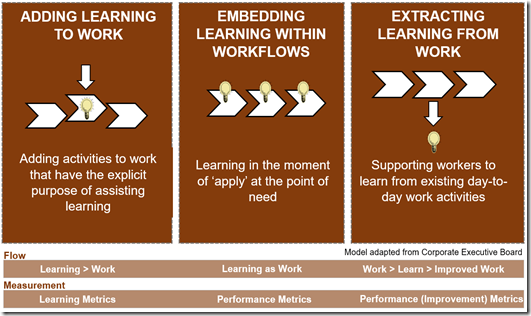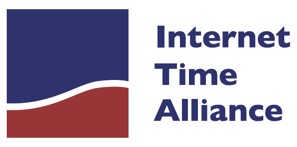High performing individuals, teams and organisations focus on exploiting development opportunities in the workplace because that’s where most of the learning happens.
Extending learning into the workplace can be achieved in a number of ways. By adding learning to work, by embedding learning with work, and by extracting learning from work. Similar models have been in use for some years. IBM’s ‘learning separate from work; ‘learning enabling work’; and ‘on-demand learning’ (2005) address similar issues.
Note: This adding-embedding-extracting model is based on earlier work by people such as Gloria Gery (embedding and extracting), the Corporate Executive Board (adding and extracting) and others. I have recently developed it further to add a fourth element ‘sharing’ (see more recent work).
 Adding Learning to Work
Adding Learning to Work
When faced with the opportunities to help with workplace learning, many HR, talent development, and learning professionals react by simply adding learning to the workflow.
Typically, adding learning involves integrating structured away-from-work learning (courses, classes, and eLearning modules) with learning activities within the workflow. An example might be the creation of some workplace activities as part of, or immediately following, a leadership development programme. Alternatively adding might involve making an eLearning module available on mobile devices, or making an online community space available for follow-up after a face-to-face course.
This approach has value but, by adding activities that are explicitly focused on assisting learning, these activities are often seen by the target group as ‘extended training’. They are also built on the idea that ‘first we learn and then we work’. The two activities are viewed as separate. That is not where the real strength of workplace learning lies.
There is also often an attempt to apply learning metrics (rather than performance metrics) to the outcomes. As such the development, although taking place in the workflow, is to a large extent ‘directed’ by the HR or Learning/Training department.
 Embedding Learning in Work
Embedding Learning in Work
Some organisations have extended beyond ‘adding’ learning to work and have put in place support so learning is ‘embedded’ in work.
Approaching workplace learning from the perspective of embedding learning in work offers a wider range of opportunities for on-going development as part of the workflow.
Learning and work merge as the need to support performance at the point-of-need drives the development of high performance. It does this efficiently and in real-time.
Electronic performance support systems (ePSS) help embed learning in work. ePSS tools have been in use for the past 25 years at least, but many HR and L&D professionals have had little exposure to their potential.
Electronic performance support has huge potential, particularly with the increasing deployment on smartphones and tablets. Gartner predicts continued growth in mobile devices and there is no doubt their use as performance support tools (beyond the ubiquity of Google access) will increase.
Embedding learning in work can also be achieved without sophisticated technology. There are many other ways to break free from the inertia of away-from-work training through simple job aids, to ‘sidekicks’ and ‘planners’. There is excellent work being carried out that supports embedding learning within workflows. ‘Job Aids & Performance Support’ by Allison Rossett & Lisa Schafer and ’Innovative Performance Support’ by Conrad Gottfredson & Bob Mosher are two publications that every learning professional should be acquainted with.
 Extracting Learning from Work
Extracting Learning from Work
The most powerful aspect of workplace learning is through extracting learning from work.
HR, Talent and Learning professionals can play an important role in optimising the extraction of learning from work, but only if they position their professional skills as facilitators and supporters of improved performance rather than as managers of process and learning.
The model of ‘learn then work’ is replaced here with ‘work then learn, then work in an improved way’. Learning is not only embedded in the workflow, but new learning is continually extracted from experiences and exchanges with colleagues, customers and the entire value chain.
As with embedding learning in the workflow, extracting the focus is on a continuous cycle of performance improvement.
Examples of this type of workplace learning include narrating work and sharing with colleagues – often achieved by micro-blogging on a regular (possibly daily) basis; active participation in professional social networks is another example. However, just as powerful is the extraction of learning that can be achieved by taking time out of a busy team or project meeting to reflect on last week’s experiences and learning in a semi-structured way.
The AAR Model for Reflection and Embedding
The AARs (After Action Reviews) of the military are simple but powerful examples of ‘embedding’ good practice. The model can easily be adapted for use in any type of organisation.
Most military forces have a similar approach, but the AAR model introduced by the US army in the 1970 to capture and disseminate critical organisational knowledge always revolves around the same four questions:
- What did we set out to do?
- What actually happened?
- Why did it happen?
- What are we going to do next time?
The process can be completed in a few minutes or may take a few hours depending on the complexity and nature of the situation. It is easily adapted for any type of organisation. The power is in its simplicity. An hour spent addressing these questions on a regular basis, or after completing a project, would provide far greater payback than reading any number of 100-page project review reports.

 ConsultMember of the Internet Time Alliance and Co-founder of the 70:20:10 Institute, Charles Jennings is a leading thinker and practitioner in learning, development and performance.
ConsultMember of the Internet Time Alliance and Co-founder of the 70:20:10 Institute, Charles Jennings is a leading thinker and practitioner in learning, development and performance.
Charles, the distinction between your three types of workplace learning is a valuable one. In your opinion where should the L&D department be putting most of its energy? Traditionally we’ve done this by “adding learning to work” – do you think that should still hold true?
I agree, Tarik. Most L&D departments have approached workplace learning simply by 'adding learning to work'. I think this has been due to the fact that 'adding' is the natural extension to structured, directed learning interventions. 'Embedding' and 'extracting' require new approaches and, to an extent, new skills. Many L&D professionals simply don't have these, or haven't been exposed to situations where they might use them. Yet performance support in the workflow ('embedding') and activities such as work narration, reflective practice and so on ('extracting') are extremely powerful – in many cases far more powerful than 'adding'.
… which inevitably leads to the next question – does L&D have the skills to do this?
I think the answer to this question is 'a few do, but many don't'.
Once we start looking at the practical ways people can be helped with 'embedding' and 'extracting' learning from work we find we're outside the L&D comfort zone pretty quickly. The skills required tend to be focused around consulting, analysis, and problem-solving. It requires a different way of thinking and planning to influence and weave development opportunities into the workflow. These are very different skills to those most L&D professionals have been encouraged to develop.
Noticed this Charles on Google+ just had a look at the main website and just want to say how pleased I am to have found your website. Lots of modules involved around Leadership, Management and looks really well designed. Just want to say well done, I have recently got access for a year to the ILM website after completing a two week course. I am much more impressed with your own way of delivering this great content and will definitely be coming back to earn more. Yours in education and development. RB.
Thanks very much for the comment, Robert. We're re-launching the 70:20:10 Forum's website soon with content more easily available (of course I'd still encourage everyone to consider full membership!)
The AAR is really useful thank you. My own study is of self organising learning environments and I think this is a good fit. The team solicit their own learning from a procedure that will soon become embedded in habit. If they can be encouraged to record the session in whatever software stores institutional knowledge then it has the potential to be disseminated too. Thanks again.
Where or how does the L & D professional gain these skills?